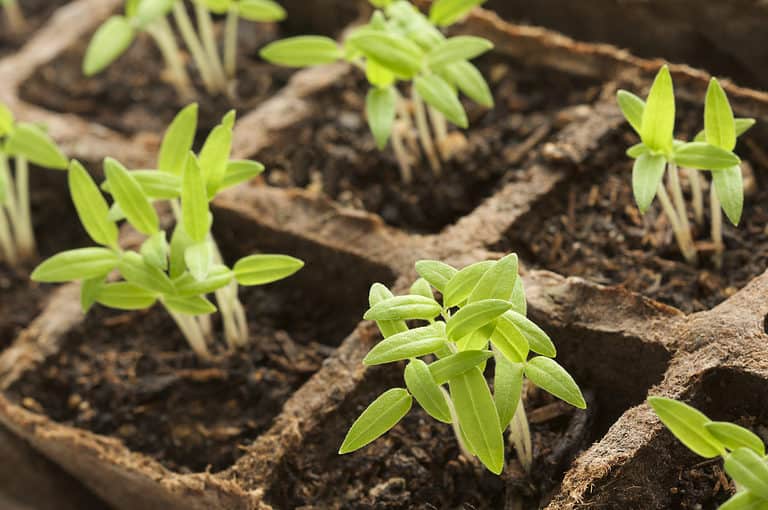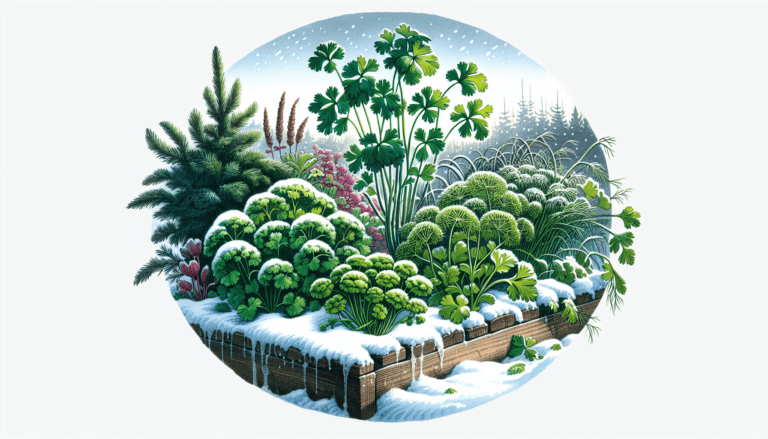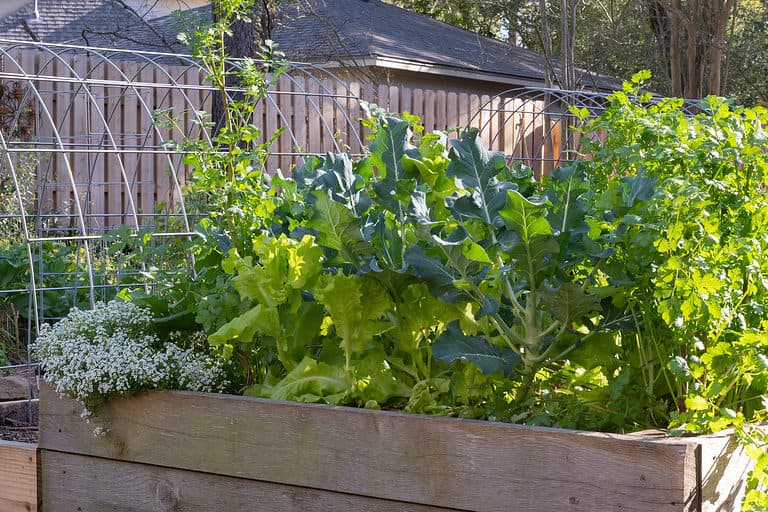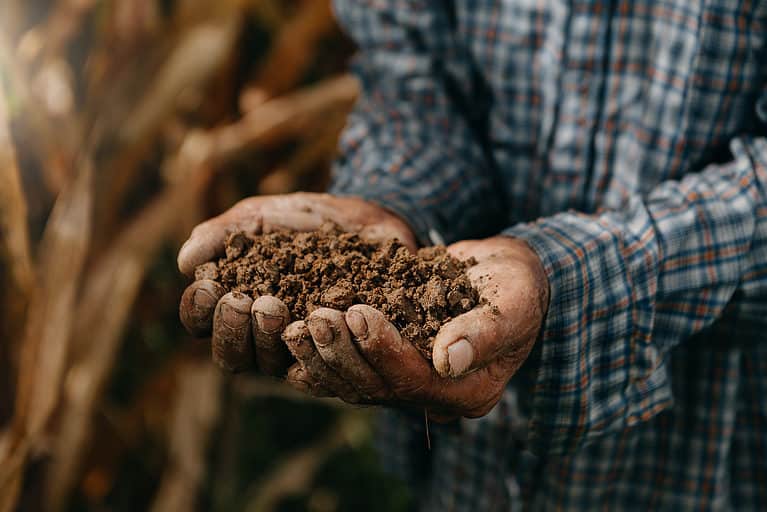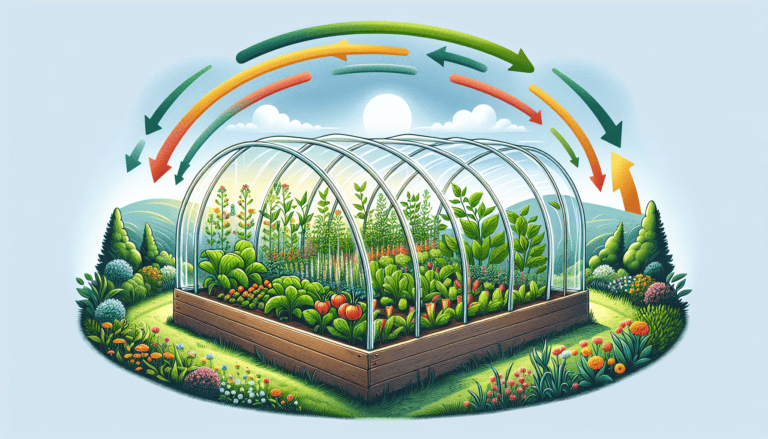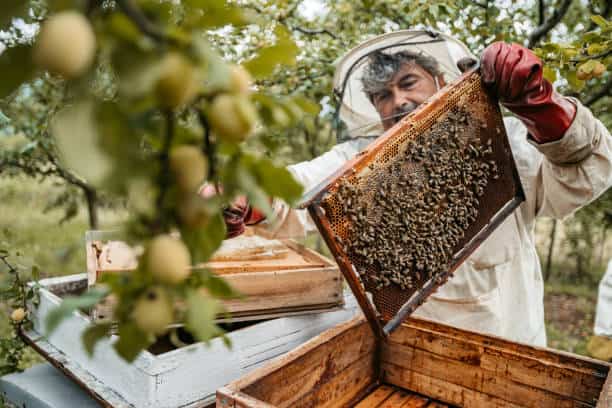Top Winter Crops to Grow for a Bountiful Cold-Season Harvest
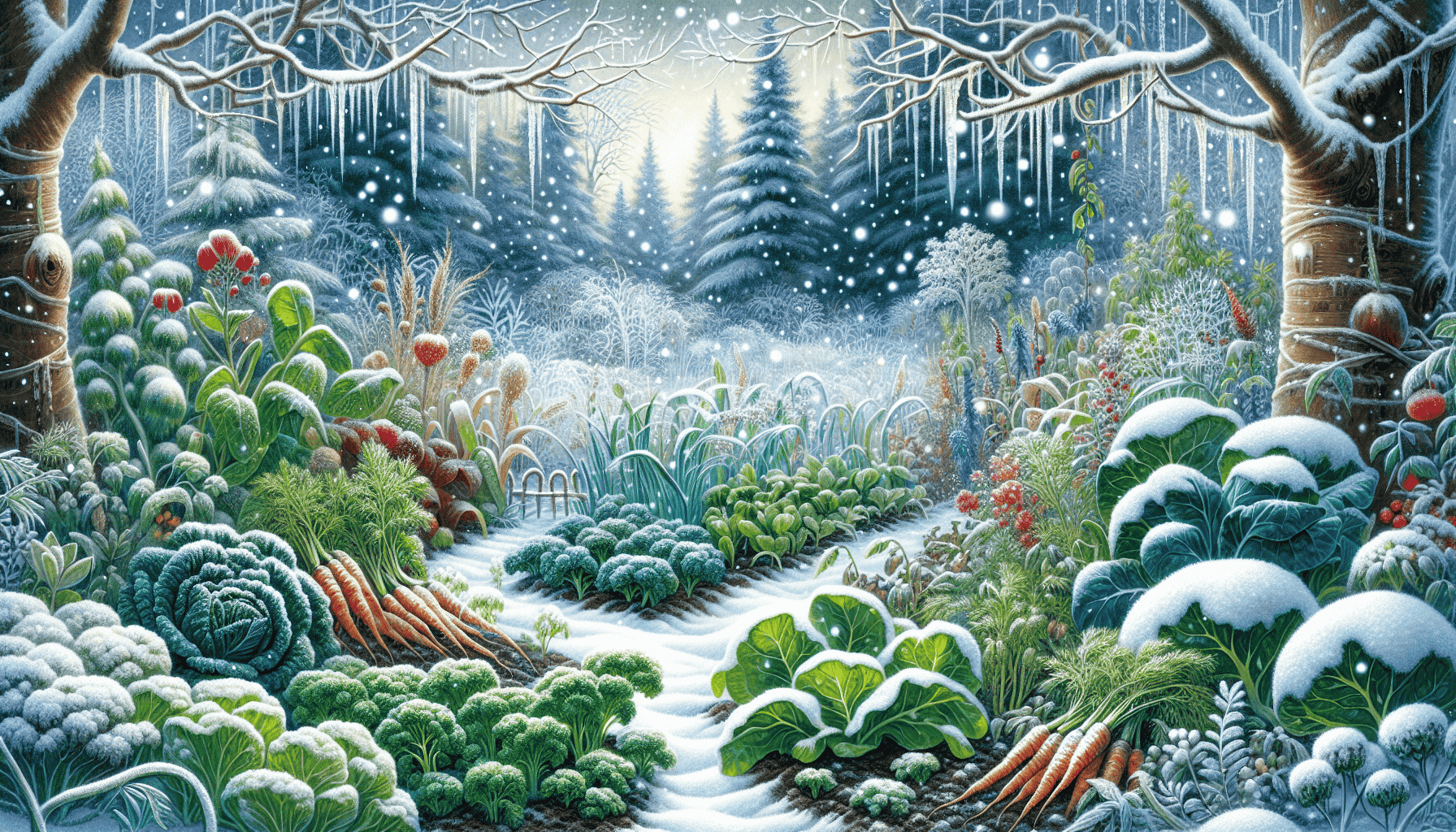
If you’re interested in cultivating crops during the winter, this piece delves into a variety of vegetables known for their cold hardiness such as kale, carrots, and spinach—capable of enduring frosty conditions. It will guide you through the process of growing these and additional hardy vegetables suited to cooler weather so that you can reap an abundant yield even when temperatures drop.
Key Takeaways
Winter gardening offers a variety of cold-hardy crops, including kale, carrots, spinach, and brassicas, enhancing flavor and nutrition during cold months.
Effective preparation methods such as mulching, soil enrichment, and using cold frames significantly boost the success of winter crops.
Implementing techniques like succession planting and proper harvesting/storage practices ensures a continuous supply of fresh produce throughout the winter season.
Essential Winter Crops for Your Garden
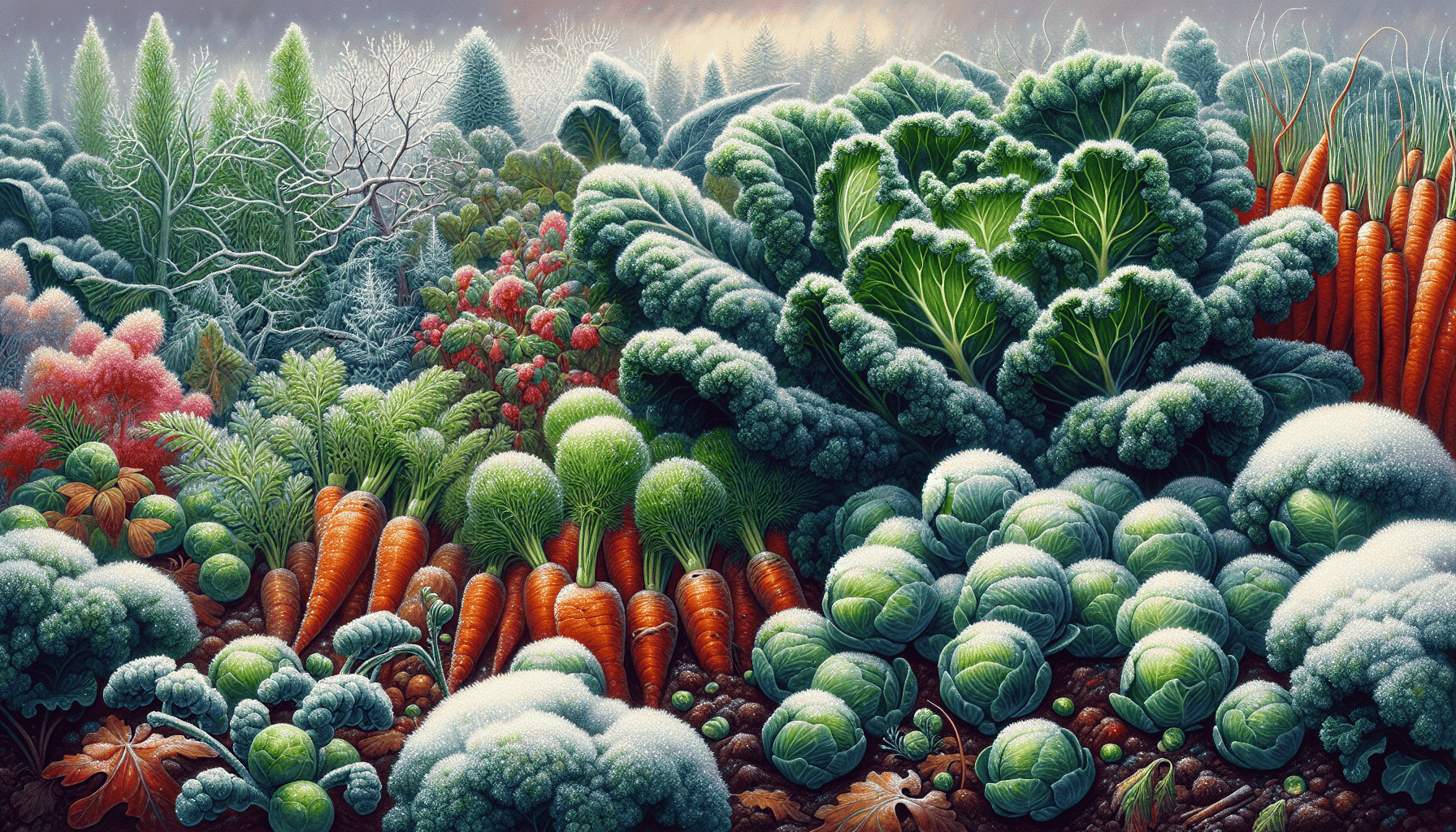
Gardening during the winter presents an array of opportunities, encompassing durable root vegetables and vigorous leafy greens. Kale, carrots, and spinach stand out as fundamental crops for this season. Notably resilient to frost, these cold-hardy vegetables don’t just survive chillier climates. Many actually develop enhanced flavors as temperatures drop.
Let’s delve into specifics about these staples of the winter garden.
Kale
Kale stands as a champion crop in the realm of winter vegetable gardening. Its robust nature allows it to flourish even during chilly conditions, with types like ‘Winterbor’ and ‘Red Russian’ being exceptionally fit for cultivating amidst cold climates. Planting these cold hardy vegetables around late summer or at the onset of fall is crucial. This timing ensures they’re firmly established by the time the first frost arrives. With proper care, kale plants can last six months or more, yielding a steady harvest of nutrient-packed leafy greens.
Renowned for its culinary flexibility, mature kale leaves are excellent additions to savory winter stews and can be transformed into delicious crispy chips. Meanwhile, tender young kale lends itself wonderfully to fresh salads. A versatile must-have for any scale of winter vegetable garden, whether you favor planting sparingly or abundantly.
The reliability of kale becomes especially precious to northern growers who regularly confront bitterly cold winter nights. The added sweetness that comes after a frost kiss only serves to improve its taste profile Beautifying those crisp winter salads with an enhanced flavor experience.
Carrots
Root vegetables such as carrots are a superb selection for winter vegetable gardens. These ‘candy carrots,’ so named because the frost enhances their sweetness, make an enchanting contribution to any winter garden setting. Notable varieties suited for cold weather include ‘Napoli’, ‘Mokum’, and ‘Bolero’ — all celebrated for their ability to withstand chilly temperatures and their tastefulness.
To achieve a prosperous harvest of these sweet roots during the colder months, it’s vital to mulch your carrot beds with either straw or shredded leaves. This layer acts as insulation against the severe chill while also preserving soil moisture levels, enabling you throughout the winter months to enjoy freshly plucked carrots from your garden. When tended properly, these root crops can offer an unbroken supply of fresh edibles even through the most frigid parts of winter.
Spinach
In the realm of winter vegetable gardening, spinach stands out as an excellent cold-hardy choice perfect for yielding a bountiful crop during the colder months. To achieve peak growth for harvesting throughout winter, it’s best to sow spinach seeds about two to three weeks prior to the anticipated first frost date. For additional protection against severe winter conditions, employing cold frames or mini hoop tunnels topped with polyethylene can help secure a successful harvest.
Certain varieties of spinach are exceptionally suited for growing in winter. These include ‘Giant Winter’, ‘Tyee’, ‘Melody’, and ‘Winter Bloomsdale’. Notably hardy, mature plants from these cultivars have been known to endure frigid temperatures plummeting as low as 15°F or even lower without succumbing—making them robust additions to any productive winter garden landscape.
Not only does its resilience make spinach a formidable player in your garden through tougher weather, but also its versatility extends into kitchen use where it becomes indispensable. Rich in nutrients and adaptable across various dishes—from crisp salads that refresh the palate, right up to savory meals that provide comfort on chilly days—spinach remains a quintessential element on any table featuring fresh produce from your flourishing winter vegetable plot.
Leafy Greens That Thrive in Cold Weather
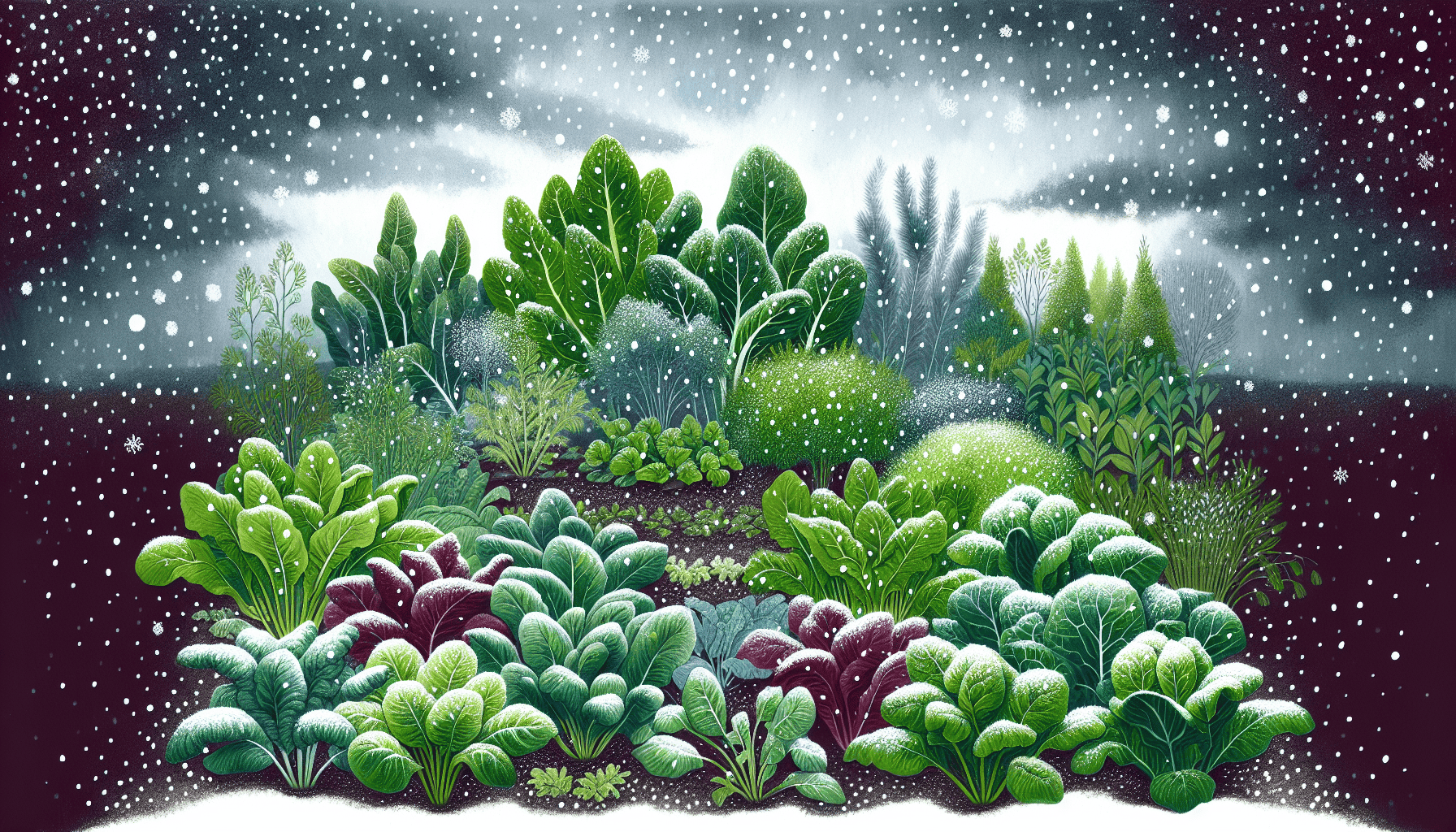
During the winter months, cultivating leafy greens can yield excellent results due to their inherent resistance to cold and ability of flourishing in cooler climates. Growing lettuce, arugula, and mache (also known as corn salad) is ideal for winter gardening enthusiasts looking to maintain a steady stream of fresh and nutrient-rich greens throughout even the chilliest periods.
The following insights pertain specifically to these robust varieties of leafy greens suitable for colder conditions.
Lettuce
For those embarking on winter vegetable gardening, lettuce stands out as an excellent starting point. Varieties like ‘Winter Density’, ‘Red Salad Bowl’, ‘Winter Marvel’, and Salanova® are particularly adept at withstanding the chilly climate and make for a thriving component in any cold-weather vegetable garden. Equally robust cultivars such as ‘Little Gem’, ‘Tango’, and ‘North Pole’ also exhibit strong growth when temperatures drop.
The resilience of leaf lettuces, romaines, and crisphead types is noteworthy. They have the ability to keep yielding edible greens well into mid-December if sheltered within a cold frame. Lettuce’s adaptability makes it indispensable for crafting winter salads or infusing meals with fresh crunchiness during colder months – truly making it a staple crop of the winter garden landscape.
Arugula
Cultivating arugula during the colder months is ideal due to its rapid growth rate and resistance to low temperatures, which positions it as a prime candidate for winter vegetable gardening. You can gather both varieties—wild and garden arugula—even in the heart of winter by cutting them down but leaving roughly 2 inches of stem behind, promoting recurring growth so you can enjoy this zesty green repeatedly.
The piquant taste of arugula brings a welcome kick to dishes, particularly enriching the character of winter salads. Given its tenacity against chillier climates, it stands out as a reliable addition to any cold season garden array, offering vibrant and tasty greens all through cooler weather periods.
Mache (Corn Salad)
Corn salad, sometimes referred to as lamb’s lettuce or mache, thrives in cold conditions and can survive temperatures as low as 5°F. This hardy green is perfect for cultivating during the winter season. Seeding it in late summer will give it enough time to take root before winter arrives. The sweet and mildly nutty taste of corn salad makes a refreshing contribution to winter salads.
When you’re ready to enjoy its delicate leaves, simply cut the stem at ground level to harvest mache. Its proclivity for self-sowing means that once established, it continues proliferating on its own—providing an ongoing yield of fresh greens throughout those chilly winter months.
Root Vegetables Perfect for Winter Gardens
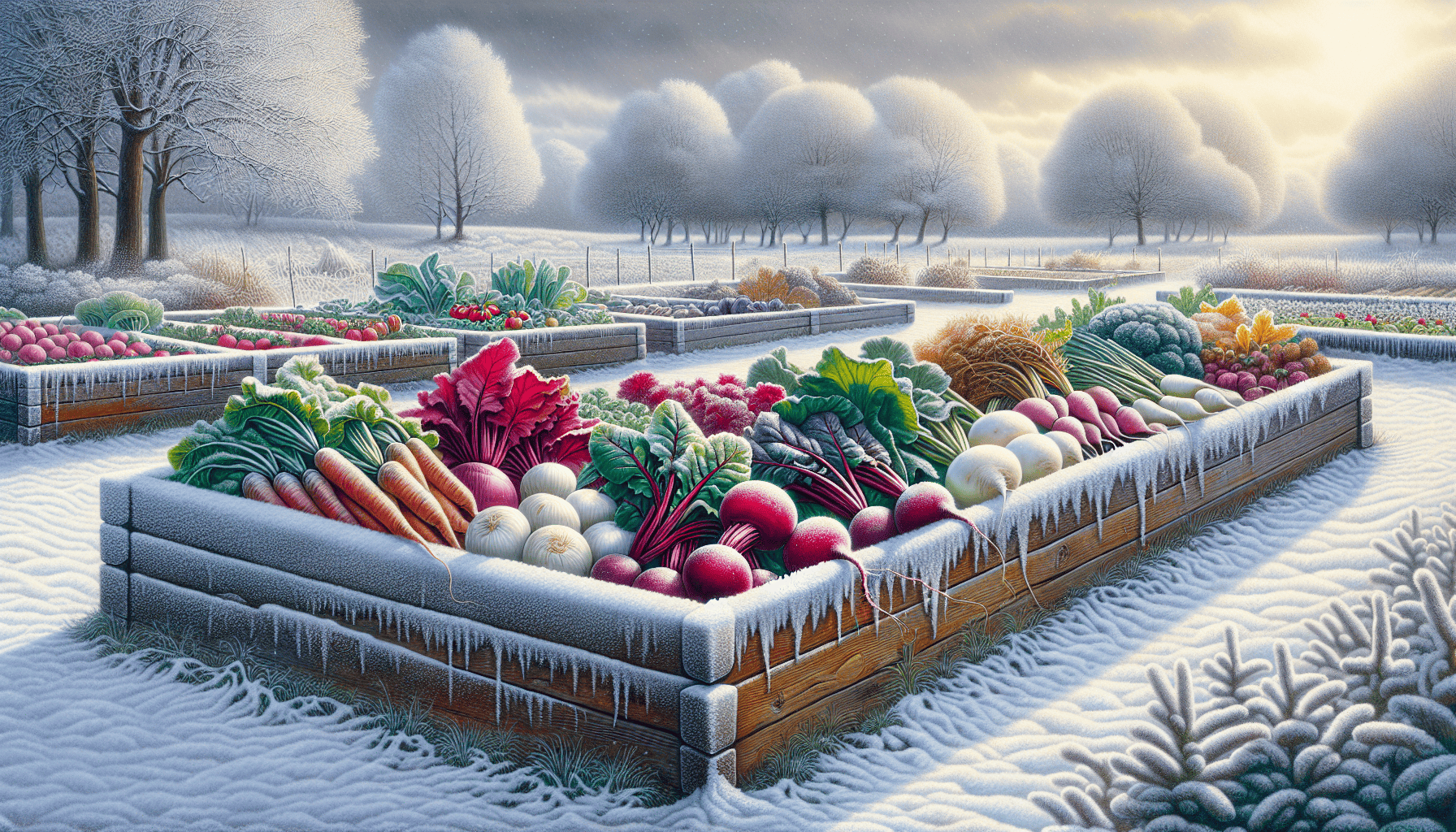
Winter gardening heavily relies on root vegetables, which are celebrated for their resilience in cold weather and ability to yield nutrient-rich produce under severe conditions. Key root crops such as carrots, beets, and turnips thrive during the winter season and become sweeter with enhanced flavors after a frost.
The following points offer critical insights into these indispensable root vegetables.
Beets
Incorporating beets into your winter vegetable garden can be highly rewarding. The ‘Lutz Green Leaf’ variety, also known as the Winter Keeper, stands out for its exceptional cold hardiness and its ability to preserve quality during colder months. For optimal taste and texture, it is recommended to harvest these root vegetables when they are between 4-6 inches in diameter before they become woody or overly bitter.
Beets offer both nutritional benefits and culinary flexibility. Their rich hues and sweet flavors enliven a range of winter recipes from roasted dishes to pickled concoctions or fresh salads. Cultivating them in your vegetable garden throughout the winter ensures you have an ongoing provision of this robust veggie that’s well-suited for hearty seasonal meals.
Turnips
Another outstanding choice for cultivating during the winter season is the turnip, a robust root vegetable. These plants are quite adept at enduring cold climates, with an ability to survive in temperatures as low as the mid-20s Fahrenheit. The ‘Purple Top White Globe’ and ‘Hakurei’ varieties stand out for their exceptional taste and resilience against the chill.
The flavor of turnips can be enhanced after they undergo light frosts, which tend to make them sweeter—thus boosting their culinary value throughout wintertime gardening endeavors. Raw or cooked into dishes such as roasts or purees, these hardy vegetables offer a flexible and wholesome component for meals amid colder months.
Parsnips
Parsnips belong to the group of hardy vegetables that thrive in cold conditions and can be gathered during winter and into early spring. Their resilience against frost positions them as a perfect choice for gardens active in the colder months. Exposure to low temperatures improves their sweetness, similar to carrots, which boosts their taste profile significantly—making them an enjoyable component of many winter meals.
To secure a plentiful harvest throughout the winter season, it’s advisable to sow parsnips from the middle towards late fall. Root vegetables with a distinctive sweet essence, they play well in various culinary creations tailored for cooler weather, enriching everything from warming soups to hearty roasted vegetable assortments.
Cold-Hardy Brassicas for Winter Gardening
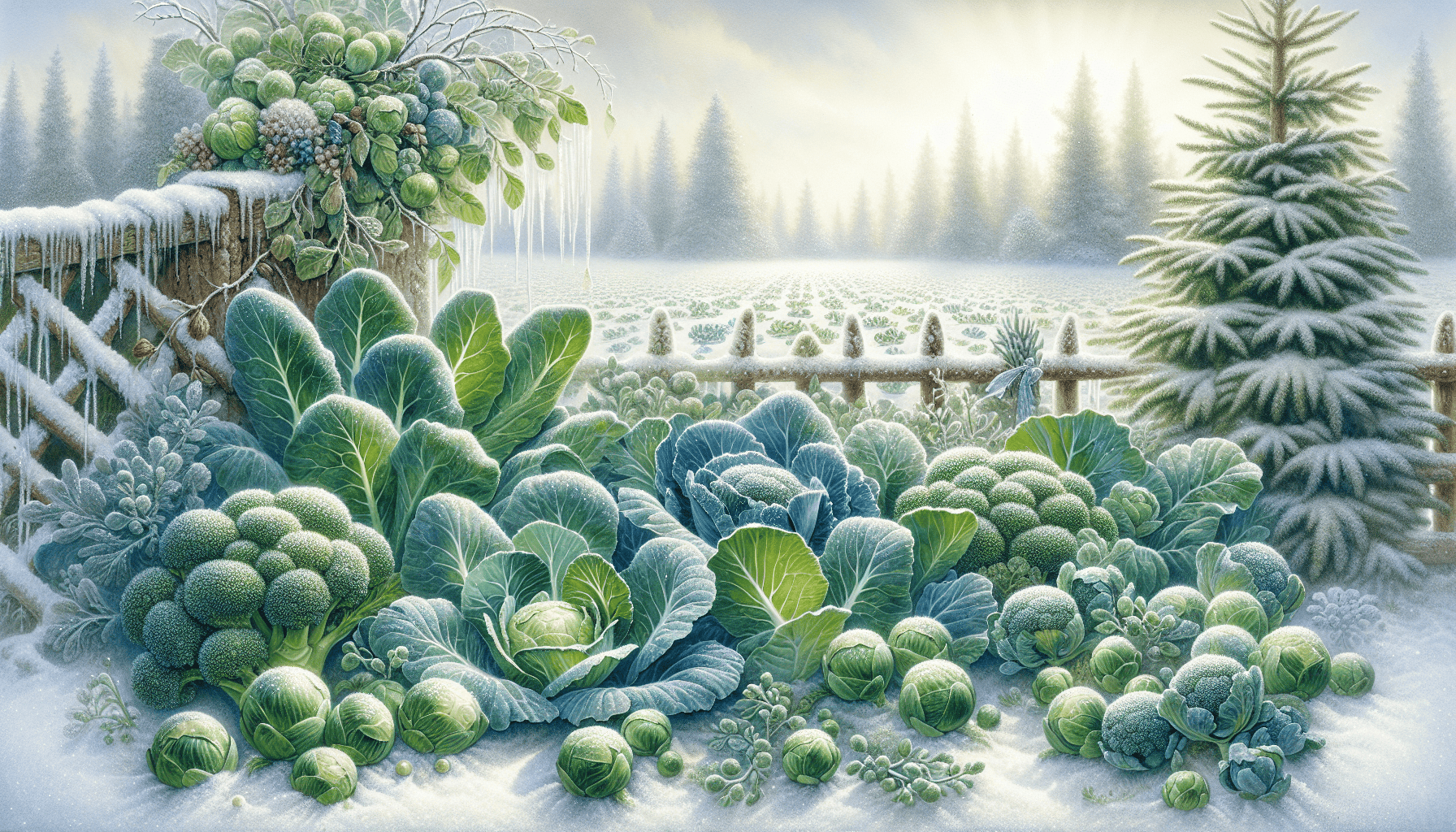
The family of brassicas encompasses a range of vegetables renowned for their ability to flourish during the winter months. These cold-hardy varieties, including Brussels sprouts, broccoli, and cabbage among others, not only withstand chillier temperatures but also provide significant nutritional value—making them indispensable additions to any winter vegetable garden.
Continuing on these robust plants:
Brussels Sprouts
Renowned for their resilience in chilly conditions, Brussels sprouts are an exceptional choice for a winter vegetable garden. These plants flourish when bathed in full sunlight and should receive no less than six hours of direct light each day. They grow best in soil that not only drains well but is also rich in nutrients with an acidic to neutral pH between 6.0 and 7.5. To promote robust growth, apply a side dressing of composted manure or fertilizer around two weeks after you’ve transplanted them.
For those aiming to reap a bountiful crop during the colder months, it’s best to plant Brussels sprouts sometime between late June and mid-August. When kissed by frost, these sprouts develop a sweeter taste that significantly improves their palatability—a delightful perk for any winter vegetable plot intended to yield fresh, tasty produce throughout the season.
Broccoli
Broccoli stands out as a top choice for those engaged in winter gardening, flourishing admirably amid the chill. Optimal planting occurs in early fall to take advantage of cooler weather conditions. Cultivars such as ‘Kariba’ and ‘Marathon’ are particularly adept at withstanding colder climates, making them ideal for winter growth.
Incorporating broccoli into your winter garden provides an ongoing source of this highly nutritious vegetable throughout the season. Given its culinary flexibility, broccoli becomes an essential component in a variety of warming dishes during winter months – perfect when roasted, steamed or tossed into hearty soups and stews.
The crispness of cold weather imparts an improved sweetness to broccoli’s taste profile. Thus it constitutes an exquisite feature among crops harvested through the frosty periods.
Cabbage
The robust nature of cabbage makes it an excellent choice for winter gardening, as it can endure the harshness of freezing temperatures. It serves as a reliable source of fresh and nutritious greens during the cooler part of the year.
Specifically tailored for colder climates, cabbage cultivars such as ‘Winter Marvel’ and ‘January King’ flourish despite lower mercury levels. Their taste is even enhanced by frosty weather. Cabbage proves to be a key winter vegetable with its versatility in dishes like salads and soups or when fermented into sauerkraut.
Asian Greens for a Diverse Winter Harvest
Incorporating Asian greens like pac choi, tatsoi, and mizuna into winter gardens can boost both variety and nutritional content. They are well-suited for colder climates as they flourish in cooler weather and have the resilience to withstand light frosts, thus ideal for growing during the winter season.
To expand on these unique and tasty vegetables:
Pac Choi
Bok choy, often called Pac Choi, stands as a robust option for a winter garden because of its hardiness in the face of cooler climates. Its ability to prosper even during light frosts renders it ideal for growing in the winter months. The chilly conditions actually serve to amplify Pac Choi’s flavor, yielding a taste that is significantly more pronounced than when grown in warmer seasons.
In culinary applications, this leafy vegetable is incredibly adaptable. It can be used in everything from stir-fries and soups to salads. Cultivating Paces. Choi throughout your cold-season garden ensures you have continuous access to these fresh and nutrient-rich greens during the colder parts of the year.
Tatsoi
Valued for its remarkable ability to resist cold temperatures, Tatsoi stands out as a robust green that can flourish during the winter season. Its tolerance to the cold contributes an exceptional taste and variety to your winter harvest.
With its subtle yet distinct mustard-like flavor, Tatsoi enhances both raw salads and various cooked meals. The plant’s endurance against severe frosts ensures it is a steadfast choice for maintaining a supply of fresh greens throughout even the coldest months in winter gardens.
Mizuna
Mizuna, with its gentle yet subtly spicy flavor, is a superb ingredient for enhancing winter salads and other dishes suited to the chilly weather. Its ability to thrive in cooler temperatures renders it an ideal option for harvesting during winter.
Incorporating mizuna into your winter garden not only adds a distinct zest to your culinary creations, but also guarantees access to fresh, nutritious leafy greens even as the cold persists. The plant’s durability in lower temperatures ensures that you can enjoy crisp, flavorful salads throughout the season.
Preparing Your Garden for Winter Crops
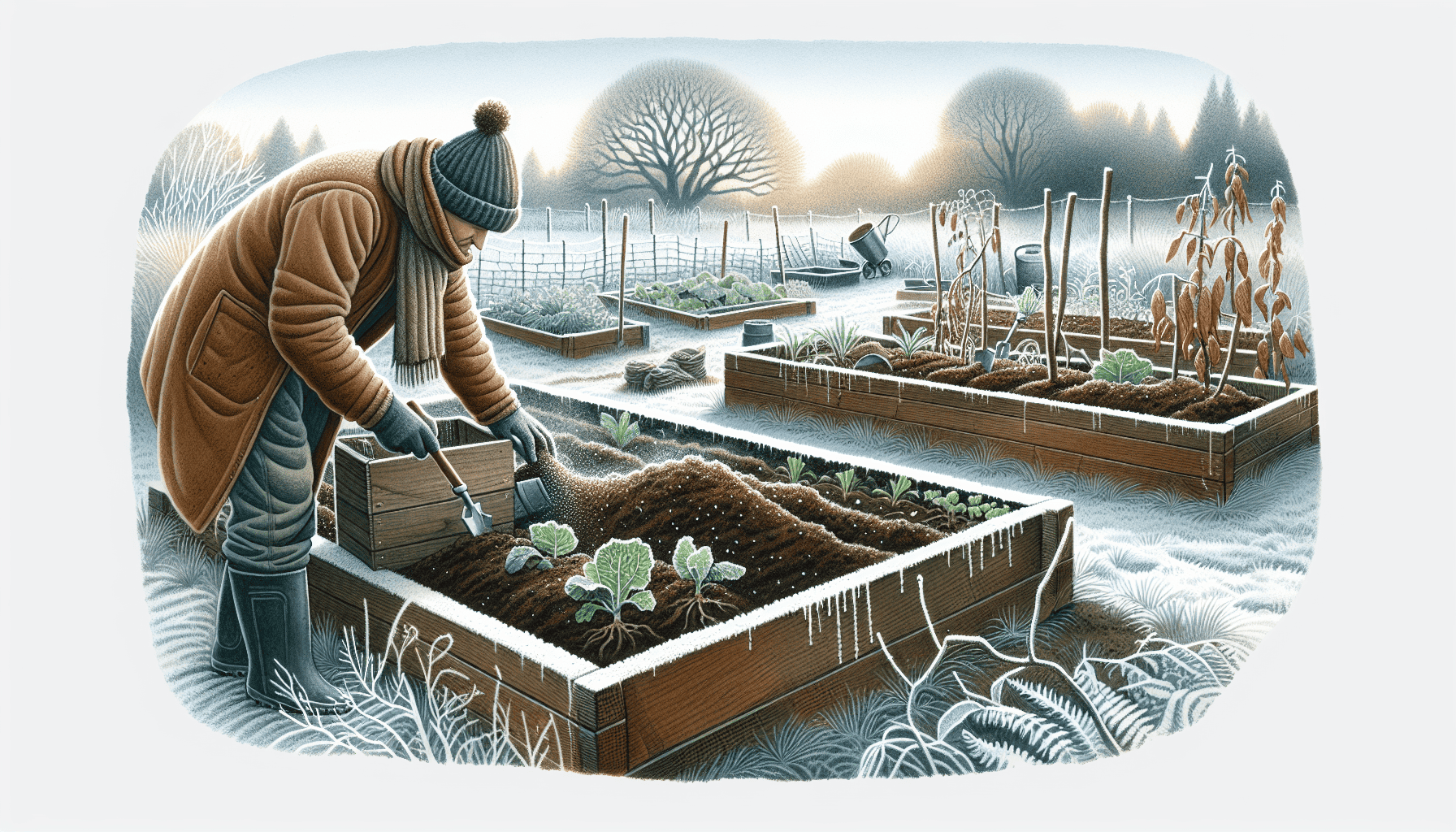
Ensuring a fruitful winter garden requires essential preparation, such as readying the soil, applying mulch properly, and implementing cold frames and row covers for protection.
Outlined below are the critical measures you need to take in order to get your winter garden prepared.
Soil Preparation
Ensuring high soil fertility is key for thriving winter crops, and this includes having adequate levels of nutrients such as nitrogen, phosphorus, and potassium. Proper drainage is essential to counter the effects of heavy winter rains on garden plants. The incorporation of compost can enhance soil structure while also helping to retain both moisture and nutrients which supports the growth during the colder months.
By conducting a soil test in autumn, you confirm that your garden’s earth contains all vital nutrients needed by winter-growing vegetation. For optimal outcomes, it’s advisable to utilize organic compost certified by OMRI. Incorporating additional phosphorus from sources like rock phosphate can be particularly beneficial for robust development in root crops.
Sowing cover crops before winter sets in offers multiple benefits: they contribute nitrogen back into the soil through fixation processes, increase organic matter content, and suppress weed growth—all contributing towards creating an ideal environment ready for planting season amid cooler temperatures.
Mulching Techniques
Implementing mulch is an essential practice for maintaining a winter vegetable garden. Utilizing shredded leaves as mulch can help maintain and stabilize soil temperature, whilst preserving the necessary moisture levels in your winter garden beds. This layer serves as crucial insulation for your plants during cold periods.
By safeguarding plant roots from the harshness of extreme cold through mulching, you essentially prolong their growing period by fostering a consistent environment that encourages plant growth.
The application of mulch remains a fundamental aspect of successful winter gardening, promoting robust health and continuous productivity within your vegetable garden throughout the duration of the winter months.
Using Cold Frames and Row Covers
Row covers and cold frames are essential assets for managing a winter vegetable garden. They offer a micro greenhouse environment through cold frames, safeguarding saplings from frostbite and facilitating an elongated cultivation period. Meanwhile, row covers serve as thermal armor against the bitter chill, incrementally elevating the warmth by 3 to 5 degrees Fahrenheit relative to the ambient outdoors.
Incorporating these season amplifiers can markedly bolster your endeavors in winter gardening. Cold frames alongside row covers deliver that extra shield against severe weather conditions, guaranteeing that your vegetable patch prospers despite exposure to extreme cold temperatures.
Planting and Sowing Winter Crops
It’s essential to pay attention to timing and methods when preparing for a winter garden. Knowledge about local frost dates, employing succession planting strategies, and initiating seed growth indoors are all vital factors that can significantly affect how well your winter crops flourish.
Consider these important techniques as you plan your approach.
Timing Your Planting
The Persephone Period is characterized by diminished daylight hours, which affects the timing of sowing seeds for winter vegetables. Recognizing this period is crucial to pinpointing the most suitable time to initiate a winter garden’s growth cycle. Planting or seeding these crops is a good idea. Takes place from mid-summer through early fall and varies according to your specific growing zone. For instance, growers in zones 4 through 6 should aim for August and September planting dates, while those in zones 7 through 10 would find early November ideal.
To ensure successful cultivation of your winter vegetation, it’s important to be aware of local frost timelines and work backward from when you intend to harvest. By doing so, you can schedule planting appropriately for each type of vegetable ensuring they are firmly established before experiencing their first frost encounter—this strategic planning contributes significantly toward a flourishing yield during the colder months.
Succession Planting
By implementing succession planting, which entails staggering seed sowing at regular intervals, a consistent stream of harvestable crops can be sustained during the winter months. Engaging in this practice by planting anew every three to four weeks helps avoid any shortages within your supply of winter vegetables.
Succession planting is especially beneficial for varieties such as leafy greens and root vegetables that can undergo several harvesting cycles over the season. This technique amplifies the yield from your winter garden, guaranteeing an ongoing availability of fresh produce throughout the duration of winter.
Starting Seeds Indoors
Initiating the growth of seeds within an indoor setting can result in more vigorous plants, thanks to their establishment of a well-developed root structure prior to being moved outdoors. This technique is especially beneficial for vegetables such as leafy greens, broccoli, and cabbage because it gives them an early advantage by growing in a regulated climate.
To successfully start seeds indoors, certain critical equipment is necessary: heat mats and grow lights provide essential warmth and light conditions, while fans help maintain appropriate air circulation. Employing methods like soil blocking can enhance productivity as well as support the wellbeing of seedlings, which simplifies the process when it’s time for them to be replanted outside.
By commencing your winter crops’ growth inside your home, you create conditions that allow these plants to emerge robustly healthy and ready for successful integration into your garden once they are transplanted.
Protecting Winter Crops from Harsh Weather
It is crucial to safeguard your winter crops against severe weather conditions if you want to reap a successful harvest. Establishing micro-climates, implementing methods for frost protection, and handling snow properly are all key strategies to make sure that your crops prosper throughout the winter months.
We will delve into these techniques in greater detail.
Creating Micro-Climates
In the practice of winter gardening, safeguarding your crops by generating micro-climates is a critical step. To achieve this, one can plant barriers that break the wind. Evergreens serve excellently in this role. They not only block chilling winds but also foster a consistent atmosphere conducive to crop growth.
To shield your winter vegetables from severe conditions and furnish them with optimal growing conditions, consider thoughtfully positioning wind breaks alongside employing various methods for creating beneficial micro-climates.
Frost Protection Methods
In the realm of winter gardening, safeguarding your plants from freezing temperatures is paramount. Utilizing row covers stands out as a straightforward and efficient strategy for frost protection. For instance, employing a frost cloth such as Agribon AG-30 can shield crops even when the mercury dips to 26°F.
For those facing exceedingly chilly climates, layering on some greenhouse plastic over the initial cover offers an enhanced level of insulation. Implementing these methods of frost defense is vital in preserving your winter garden’s yield through to harvest time successfully.
Snow Management
It is crucial to handle snow buildup with care in order to prevent harm to your winter vegetable garden. Employing plastic coverings can shield the plants from snowfall, yet it’s important that these covers do not make direct contact with the vegetation, as this could lead to damage from cold temperatures.
By implementing suitable protective measures and managing snow effectively, you ensure that your winter vegetable garden remains thriving and robust.
Harvesting and Storing Winter Vegetables
To maximize your winter harvest and ensure a supply of fresh produce throughout the colder months, it’s crucial to master the timing for harvesting winter vegetables, utilize correct harvesting techniques, and implement effective storage practices.
When to Harvest
To guarantee the most flavorful and high-quality taste from your winter crop harvest, it is crucial to focus on timing for optimal peak flavor. Securing that winter crops are harvested at precisely the right moment hinges upon various considerations including plant maturity and prevailing weather conditions, all of which play a pivotal role in pinpointing the perfect time to harvest.
Upholding best practices like picking your vegetables during the cooler segments of the day can significantly preserve their quality. By meticulously scheduling when to gather your crops, you’re making sure that these winter vegetables truly represent their finest state when brought to table.
Harvesting Techniques
To guarantee the best taste and texture, winter crops must be picked at the optimal time. Keep an eye on changes in size and color to determine this. A light frost can actually improve the flavor of certain vegetables such as carrots and kale, making them sweeter.
When extracting root vegetables, including beets or carrots, from the ground, carefully ease up the surrounding soil to avoid harm to these edibles. In contrast, when harvesting leafy greens like spinach or kale, employ shears or a keen blade to snip off leaves so that more may continue sprouting from the plant.
Post-harvesting involves delicately cleansing your produce before storing it away in an environment that is not only cool and shadowed but also moist. Doing so helps maintain their freshness for extended periods.
Storage Methods
It’s crucial to employ the right storage techniques to maintain the freshness of winter vegetables over time. Take beets, for instance. After washing them thoroughly, they should be stored in a refrigerator or root cellar, particularly during bouts of extreme cold. Similarly, daikon radishes can retain their quality longer when their greens are removed and they’re kept in a root cellar.
Employing these methods will help preserve your winter harvest so it remains fresh and full of nutrients for several months. By harvesting at optimal times and utilizing appropriate storage strategies, you can ensure that your homegrown vegetables continue to grace your table throughout each season.
Summary
Engaging in winter gardening provides a distinctive and fulfilling chance to partake in fresh, wholesome vegetables even during the cooler season. By getting acquainted with vital winter crops, readying your garden space, and utilizing adept methods for planting, safeguarding, and collecting your yield, you can guarantee an abundant supply during the winter harvest. Accept the rewarding endeavor of cultivating throughout winter. This will bless you with an uninterrupted stream of tasty produce from your own efforts year-round.
Frequently Asked Questions
What are the best winter vegetables to grow?
Cultivating winter vegetables such as kale, carrots, and spinach offers both pleasure and rewards. By including crops like Brussels sprouts and broccoli, you can ensure a flourishing winter garden that fully takes advantage of the season!
How can I protect my winter crops from frost?
To shield your winter vegetation from the harshness of frost, it’s advisable to utilize protective measures such as cold frames, row covers, or plastic meant for greenhouses. Establishing micro-climates by setting up barriers against the wind can provide extra protection.
Do not delay in implementing these strategies if you want to secure your plants and guarantee an abundant yield!
When is the best time to plant winter crops?
To ensure a successful garden, it’s crucial to plant your winter crops from the middle of summer through to the start of autumn, taking into account the particular growing zone in which you live.
Grasping the timing of local frost dates will help you prepare your garden for optimal growth and yield.
How do I store winter vegetables after harvesting?
Preserve the freshness of your winter vegetables by storing them in a place that is cool, dark, and maintains humidity levels similar to those found in fridges or root cellars. Make sure to remove the greens beforehand.
By doing so, you can maintain their delicious flavor and bright appearance for an extended period!
What are some good mulching techniques for winter gardens?
Using shredded leaves as mulch is a fantastic way to protect your winter garden by regulating soil temperature and retaining moisture.
Embrace this technique to insulate your plant roots and keep them healthy and productive all season long!

